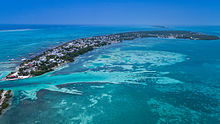Cay
![]()
This article is about small islands. For other meanings, see CAY.
![]()
This article or subsequent section is not sufficiently supported by evidence (e.g., anecdotal evidence). Information without sufficient evidence may be removed in the near future. Please help Wikipedia by researching the information and adding good supporting evidence.
A cay (English cay, caye, key [ˈkiː or ˈkeɪ] ← [via Span.(-port.) cayo] from taíno kayo) is a small flat island composed of coral and sand deposits.
Particularly well known are the Cays, which form the island chain of the Florida Keys in the US state of Florida, one of which is Key West.
The term "cay" (or "caye") is often used for small Caribbean islands, such as those in the Belize Barrier Reef (e.g. Caye Caulker) or in the Bahamas, which includes some 2,400 cays (e.g. Rum Cay). In the 20th century, the Bahamian cays Little Stirrup Cay and Great Stirrup Cay, which are part of the Berry Islands, became famous when the cruise lines Royal Caribbean International and Norwegian Cruise Line bought them and made them exclusive vacation destinations for their passengers. Some coral islands of the Great Barrier Reef off Australia (e.g. Capricornia Cays National Park) and in the Indian Ocean are also called "cays".

Aerial view Caye Caulker, Belize

Sand from a Cay under the light microscope, incident light
Questions and Answers
Q: What is a cay?
A: A cay is a small, low island made of mostly sand or coral and on top of a coral reef.
Q: Where does the word "cay" come from?
A: The English word cay comes from the Spanish word cayo and this from the Taíno word cayo meaning "small island".
Q: How do other words related to "cay" originate?
A: The English words key and quay (which means wharf) come from the old French kai meaning "sand bank".
Q: Where are cays typically found?
A: Cays are typically found in tropical seas where there are coral reefs.
Q: What affects the formation of cays?
A: Weather affects the formation of cays greatly. Large tides bring much more debris onto the cay and make it larger, while a hurricane destroys a cay.
Q: Are some large enough for tourism purposes?
A: Yes, some large enough for tourism purposes; Cayo Coco, north of Cuba, is about 370 km2. Those large cays are being used for tourism because they have beaches with white sand and the presence of coral reefs.
Q: What makes these large ones suitable for tourism?
A: These large ones suitable for tourism because they have beaches with white sand and the presence of coral reefs.
Search within the encyclopedia